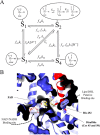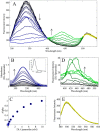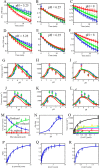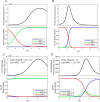Global Kinetic Analysis of Mammalian E3 Reveals pH-dependent NAD+/NADH Regulation, Physiological Kinetic Reversibility, and Catalytic Optimum
- PMID: 26644471
- PMCID: PMC4742739
- DOI: 10.1074/jbc.M115.676619
Global Kinetic Analysis of Mammalian E3 Reveals pH-dependent NAD+/NADH Regulation, Physiological Kinetic Reversibility, and Catalytic Optimum
Abstract
Mammalian E3 is an essential mitochondrial enzyme responsible for catalyzing the terminal reaction in the oxidative catabolism of several metabolites. E3 is a key regulator of metabolic fuel selection as a component of the pyruvate dehydrogenase complex (PDHc). E3 regulates PDHc activity by altering the affinity of pyruvate dehydrogenase kinase, an inhibitor of the enzyme complex, through changes in reduction and acetylation state of lipoamide moieties set by the NAD(+)/NADH ratio. Thus, an accurate kinetic model of E3 is needed to predict overall mammalian PDHc activity. Here, we have combined numerous literature data sets and new equilibrium spectroscopic experiments with a multitude of independently collected forward and reverse steady-state kinetic assays using pig heart E3. The latter kinetic assays demonstrate a pH-dependent transition of NAD(+) activation to inhibition, shown here, to our knowledge, for the first time in a single consistent data set. Experimental data were analyzed to yield a thermodynamically constrained four-redox-state model of E3 that simulates pH-dependent activation/inhibition and active site redox states for various conditions. The developed model was used to determine substrate/product conditions that give maximal E3 rates and show that, due to non-Michaelis-Menten behavior, the maximal flux is different compared with the classically defined kcat.
Keywords: enzyme kinetics; flavoprotein; global fitting; kcat; mathematical modeling; mitochondrial metabolism; pyruvate dehydrogenase complex (PDC).
© 2016 by The American Society for Biochemistry and Molecular Biology, Inc.
Figures














Similar articles
-
A pH-dependent kinetic model of dihydrolipoamide dehydrogenase from multiple organisms.Biophys J. 2014 Dec 16;107(12):2993-3007. doi: 10.1016/j.bpj.2014.09.025. Biophys J. 2014. PMID: 25517164 Free PMC article.
-
The interaction between lipoamide dehydrogenase and the peripheral-component-binding domain from the Azotobacter vinelandii pyruvate dehydrogenase complex.Eur J Biochem. 1995 Dec 15;234(3):861-70. doi: 10.1111/j.1432-1033.1995.861_a.x. Eur J Biochem. 1995. PMID: 8575446
-
The mechanism of the quinone reductase reaction of pig heart lipoamide dehydrogenase.Biochem J. 1990 Jul 1;269(1):101-5. doi: 10.1042/bj2690101. Biochem J. 1990. PMID: 2375745 Free PMC article.
-
Lipoamide dehydrogenase from Escherichia coli. Steady-state kinetics of the physiological reaction.J Biol Chem. 1989 May 15;264(14):8039-45. J Biol Chem. 1989. PMID: 2498307
-
Pig heart lipoamide dehydrogenase: solvent equilibrium and kinetic isotope effects.Biochemistry. 1992 Mar 31;31(12):3065-72. doi: 10.1021/bi00127a006. Biochemistry. 1992. PMID: 1554695
Cited by
-
Redox imbalance and mitochondrial abnormalities in the diabetic lung.Redox Biol. 2017 Apr;11:51-59. doi: 10.1016/j.redox.2016.11.003. Epub 2016 Nov 17. Redox Biol. 2017. PMID: 27888691 Free PMC article.
-
Dihydrolipoamide dehydrogenase, pyruvate oxidation, and acetylation-dependent mechanisms intersecting drug iatrogenesis.Cell Mol Life Sci. 2021 Dec;78(23):7451-7468. doi: 10.1007/s00018-021-03996-3. Epub 2021 Oct 31. Cell Mol Life Sci. 2021. PMID: 34718827 Free PMC article. Review.
-
Evidence of a preferred kinetic pathway in the carnitine acetyltransferase reaction.Arch Biochem Biophys. 2020 Sep 30;691:108507. doi: 10.1016/j.abb.2020.108507. Epub 2020 Jul 22. Arch Biochem Biophys. 2020. PMID: 32710884 Free PMC article.
-
The Molecular Effects of Dietary Acid Load on Metabolic Disease (The Cellular PasaDoble: The Fast-Paced Dance of pH Regulation).Front Mol Med. 2021 Nov 16;1:777088. doi: 10.3389/fmmed.2021.777088. eCollection 2021. Front Mol Med. 2021. PMID: 39087082 Free PMC article. Review.
-
Detailed evaluation of pyruvate dehydrogenase complex inhibition in simulated exercise conditions.Biophys J. 2021 Mar 2;120(5):936-949. doi: 10.1016/j.bpj.2021.01.018. Epub 2021 Jan 28. Biophys J. 2021. PMID: 33515599 Free PMC article.
References
-
- Perham R. N. (2000) Swinging arms and swinging domains in multifunctional enzymes: catalytic machines for multistep reactions. Annu. Rev. Biochem. 69, 961–1004 - PubMed
-
- Massey V. (1960) The identity of diaphorase and lipoyl dehydrogenase. Biochim. Biophys. Acta 37, 314–322 - PubMed
-
- Brautigam C. A., Chuang J. L., Tomchick D. R., Machius M., and Chuang D. T. (2005) Crystal structure of human dihydrolipoamide dehydrogenase: NAD+/NADH binding and the structural basis of disease-causing mutations. J. Mol. Biol. 350, 543–552 - PubMed
Publication types
MeSH terms
Substances
Associated data
- Actions
- Actions
Grants and funding
LinkOut - more resources
Full Text Sources

